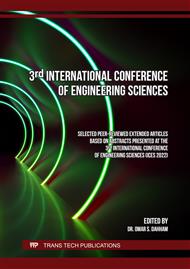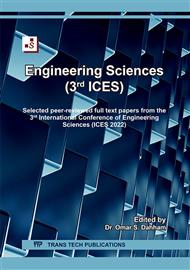[1]
Nicholson PG. Chapter 11 - admixture soil Improvement BT - soil improvement and ground modification methods. In: Soil Improv. Gr. Modif. Methods, Butterworth Heinemann, Boston; 2015. p.231–88.
DOI: 10.1016/b978-0-12-408076-8.00011-x
Google Scholar
[2]
Finch H.J.S., Samuel A.M., Lane G.P.F., "Soils and soil management, Woodhead Publishing Series in Food Science", Technology and Nutrition, Lockhart and Wiseman's Crop Husbandry Including Grassland (Eighth Edition),Woodhead Publishing, Pages 26-51.
DOI: 10.1533/9781855736504.1.25
Google Scholar
[3]
Prusinski J, Bhattacharja RS. "Effectiveness of Portland cement and lime stabilizing clay soils". Transp Res Rec, Transportation Res Board 1999:215–27.
DOI: 10.3141/1652-28
Google Scholar
[4]
Waheed M. Q., Asmael N.M., 2018. "Improvement of engineering soil properties using non -traditional additives MATEC Web Conf". 162 01027 (2018).
DOI: 10.1051/matecconf/201816201027
Google Scholar
[5]
Abbasi, N., Mahdieh, M. and Davoudi, M. H., (2013), "Application of Lime and Pozzolan for Stabilization of Silty Sand Soils in Irrigation and Drainage Networks" Journal of Science & Technology of Agriculture & Natural Resources, Vol. 16, No. 62, pp.245-257.
Google Scholar
[6]
Mohamada S. A., Mohamada H.A. Fattah M. Y., 2022. "Using High Reactivity Attapulgite for Stabilizing Collapsible Gypseous Soil", International Journal of Sustainable Development and Planning Vol. 17, No. 1, February, 2022, pp.165-172.
DOI: 10.18280/ijsdp.170116
Google Scholar
[7]
American Society of Testing and Materials (ASTM) (2010),"Standard Test Method for Liquid Limit, Plastic Limit, and Plasticity Index of Soil", ASTM D 4318, West Conshohocken, Pennsylvania, USA.
Google Scholar
[8]
American Society of Testing and Materials (ASTM) (2010). " Standard Test Method for Specific Gravity " ASTM D 854, West Conshohocken, Pennsylvania, USA.
Google Scholar
[9]
American Society of Testing and Materials (ASTM) (2010). " Standard Test Method for Particle Size Analysis of Soils" ASTM D 422, West Conshohocken, Pennsylvania, USA.
Google Scholar
[10]
Malviya, R. (2011). "Extraction characterization and evaluation of selected mucilage as pharmaceutical excipient". Polimery W Medycynie, 41, 39–44.
Google Scholar
[11]
ASTM D1557, (2000) Standard Test Methods for Laboratory Compaction Characteristics of Soil Using Standard Effort, Annual Book of ASTM Standards, ASTM International, West Conshohocken, PA, United States.
DOI: 10.1520/mnl12165m
Google Scholar
[12]
ASTM D2166, (2000) Standard Test Method for Unconfined Compressive Strength of Cohesive Soil, West Conshohocken, PA, United States.
Google Scholar
[13]
Salim, M. N., Baqir, H. H., and Al-Soudany, K. Y. (2015)" Cement – Lime Additives to Stabilize Iraqi Soils", The 2nd International Conference of Buildings, Construction and Environmental Engineering (BCEE2-2015).
Google Scholar
[14]
American Society of Testing and Materials (ASTM) (2010), "One‐Dimensional Consolidation Properties of Soils Using Incremental Loading ", ASTM D 2435, West Conshohocken, Pennsylvania, USA.
Google Scholar



